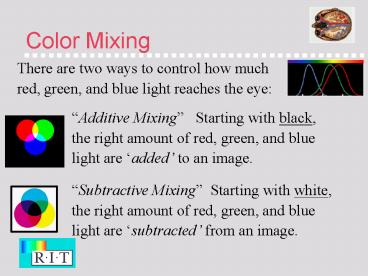Color Mixing - PowerPoint PPT Presentation
1 / 17
Title:
Color Mixing
Description:
Temporal Mixing (Digital Cinema) Because the visual system has limited temporal resolution, rapidly changing colors are mixed perceptually. – PowerPoint PPT presentation
Number of Views:470
Avg rating:3.0/5.0
Title: Color Mixing
1
Color Mixing
There are two ways to control how much red,
green, and blue light reaches the eye
Additive Mixing Starting with black, the
right amount of red, green, and blue light are
added to an image. Subtractive Mixing
Starting with white, the right amount of red,
green, and blue light are subtracted from an
image.
2
Additive Color Mixing
By exciting the red, green, and blue sensitive
cones, any color can be produced by adding
together the three additive primaries (R,G,B).
- Mixing the three color sources is known as
additive mixing to distinguish it from mixing
paints or dyes (subtractive mixing).
3
Additive Color Mixing
For example, when blue and green lights overlap,
the blue and green cones are illuminated, and we
perceive cyan
4
Additive Color Mixing
green blue cyan
- red blue magenta
red green blue white
red green yellow
5
Additive Color Mixing
red green/2 orange
red green yellow
red/2 green lime
red green blue white
red green blue gray
red green blue gray
6
Additive Color Reproduction
- Color video projectors use additive color mixing
- Projected red, green, and blue images contribute
RGB components to create color images
7
Additive Color Mixing Methods
- In addition to the superposition method described
above, there are two other methods of mixing R,
G, B primaries. - - Spatial mixing (as in color TV)
- - Temporal mixing (as in digital cinema)
- Both rely on limitations of the visual system
8
Spatial Mixing (Video Monitor)
- Because the visual system has limited spatial
resolution, small areas of different colors are
mixed perceptually.
Spatial addressability of typical monitors goes
from (640 x 480) to (1600 x 1280) pixels.
9
Temporal Mixing (Digital Cinema)
- Because the visual system has limited temporal
resolution, rapidly changing colors are mixed
perceptually.
time
time
time
10
Color Monitors
- A number of color monitors exist in most digital
color document systems. - Different color monitors are likely to display
the same digital file differently.
11
Subtractive Color Mixing
- Color hardcopy devices cant use additive mixing
because they arent sources of light they cant
add Red, Green, or Blue components.
Instead, they use subtractive mixing. Starting
with white light reflected by the substrate, they
subtract the unwanted red, green, and blue
components using cyan, magenta, and yellow
colorants.
12
Subtractive Color Mixing
- The goal is the same to control the amount of
Red, Green, and Blue light getting to the eyes
three cone types - Each colorant absorbs 1/3 and transmits 2/3 of
white light
white substrate
cyan colorantminus red
magenta colorantminus green
yellow colorantminus blue
13
Subtractive Color Mixing
- Other colors are made by varying the amount of
colorant in each layer.
yellow magenta red
yellow magenta
yellow magenta/2 orange
cyan black
14
Subtractive Color Reproduction
- Color printing uses subtractive color mixing.
- Adding black allows more accurate grays, and
conserves the more expensive CMY colorants.
15
Subtractive Color Imaging
- Colors are rendered by different mixtures of
cyan, magenta, and yellow inks printed. - Gradations in each channel can be achieved by
halftone marking.
16
Subtractive Color Imaging
- Process color printing is an example of
subtractive color mixing - The spatial addressability of typical printers
goes from 400 spots/in to 3,600 spots/in.
17
Subtractive Color Imaging
- Assumptions
- White substrate (or paper) is used
- It reflects all red, green, and blue light
- Process inks are semi-transparent
- Each ink absorbs 1/3 of the visible
spectrumcyan subtracts red, transmits green and
bluemagenta subtracts green, transmits red and
blueyellow subtracts blue, transmits red and
green































